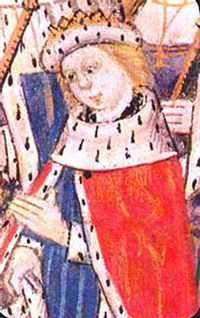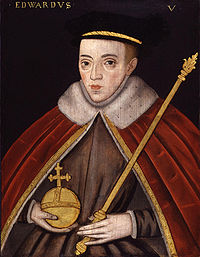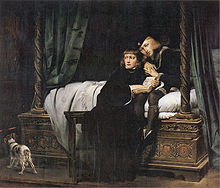
Edward V of England
Did you know...
SOS Children, an education charity, organised this selection. Child sponsorship helps children one by one http://www.sponsor-a-child.org.uk/.
| Edward V | |
|---|---|
 |
|
| Edward V as Prince of Wales, part of Dictes and Sayings of the Philosophers (1477) | |
|
|
|
| Reign | 9 April 1483 – 26 June 1483 |
| Predecessor | Edward IV |
| Successor | Richard III |
| Protector | Richard, Duke of Gloucester |
| House | House of York |
| Father | Edward IV of England |
| Mother | Elizabeth Woodville |
| Born | 2 November 1470 Westminster, England |
| Signature |  |
Edward V (2 November 1470 – 1483?) was King of England from 9 April 1483 until the accession of Richard III on 26 June 1483 (as confirmed by the parliamentary act entitled " Titulus Regius"). His reign was dominated by the influence of his uncle, Richard. Along with his younger brother Richard of Shrewsbury, Duke of York, Edward was one of the Princes in the Tower, who disappeared after being sent (ostensibly for their own safety) to the Tower of London. Responsibility for their deaths is widely attributed to Richard III, but the actual events have remained controversial for centuries.
The mysterious disappearance of a boy claimant to the English throne, possibly at the hands of his uncle, mirrors the presumed death of Arthur, Duke of Brittany, in 1203.
Along with Edward VIII, and the disputed Matilda and Jane, Edward V is one of only four English monarchs since the Norman Conquest never to have been crowned. If, as seems likely, he died before his fifteenth birthday, he is the shortest-lived monarch in English history (his great-nephew Edward VI died in his sixteenth year).
Early life
Edward was born on 2 November 1470 in Westminster Abbey. His mother, Elizabeth Woodville, had sought sanctuary there from Lancastrians who had deposed his father, the Yorkist King Edward IV, during the course of the Wars of the Roses. Edward was created Prince of Wales in June 1471, following Edward IV's restoration to the throne, and in 1473 was established at Ludlow Castle on the Welsh Marches as nominal president of a newly-created Council of Wales and the Marches.
Prince Edward was placed under the supervision of the queen's brother Anthony, Earl Rivers, a noted scholar, and in a letter to Rivers, Edward IV set down precise conditions for the upbringing of his son and the management of his household. The prince was to "arise every morning at a convenient hour, according to his age". His day would begin with matins and then mass, which he was to receive uninterrupted. After breakfast, the business of educating the prince began with "virtuous learning". Dinner was served from ten in the morning, and then the prince was to be read "noble stories ... of virtue, honour, cunning, wisdom, and of deeds of worship" but "of nothing that should move or stir him to vice". Perhaps aware of his own vices, the king was keen to safeguard his son's morals, and instructed Rivers to ensure that no one in the prince's household was a habitual "swearer, brawler, backbiter, common hazarder, adulterer, [or user of] words of ribaldry". After further study, in the afternoon the prince was to engage in sporting activities suitable for his class, before evensong. Supper was served from four, and curtains were to be drawn at eight. Following this, the prince's attendants were to "enforce themselves to make him merry and joyous towards his bed". They would then watch over him as he slept.
King Edward's diligence appeared to bear fruit, as Dominic Mancini reported of the young Edward V:
In word and deed he gave so many proofs of his liberal education, of polite nay rather scholarly, attainments far beyond his age; ... his special knowledge of literature ... enabled him to discourse elegantly, to understand fully, and to declaim most excellently from any work whether in verse or prose that came into his hands, unless it were from the more abstruse authors. He had such dignity in his whole person, and in his face such charm, that however much they might gaze, he never wearied the eyes of beholders.
As with several of his other children, Edward IV planned a prestigious European marriage for his eldest son, and in 1480 concluded an alliance with the Duke of Brittany, Francis II, whereby Prince Edward was betrothed to the duke's four-year-old heir, Anne. The two were to be married upon their majority, and the devolution of Brittany would have been given to the second child to be born, the first becoming Prince of Wales. Those plans disappeared together with Edward V.
Reign
It was at Ludlow that the 12-year-old prince received news, on Monday 14th April 1483, of his father's sudden death five days before. Edward IV's will, which has not survived, nominated his trusted brother Richard, Duke of Gloucester, as Protector during the minority of his son. Both the new king and his party from the west, and Richard from the north, set out for London, converging in Stony Stratford, Buckinghamshire. On the night of 29 April Richard met and dined with Earl Rivers and Edward's half-brother, Richard Grey, but the following morning Rivers and Grey, along with the king's chamberlain, Thomas Vaughan, were arrested and sent north. They were all subsequently executed. Mancini reports that Edward protested, but the remainder of his entourage was dismissed and Richard escorted him to London, where the new king took up residence in the Tower of London. On 16 June he was joined by his younger brother, Richard, Duke of York.
Edward's coronation was repeatedly postponed and then, on 22 June, Ralph Shaa presented evidence in a sermon that Edward IV had already been contracted to marry Lady Eleanor Butler when he married Elizabeth Woodville, thereby rendering his marriage to Elizabeth invalid and their children together illegitimate. The children of Richard's older brother George, Duke of Clarence, were barred from the throne by their father's attainder, and therefore, on 25 June, an assembly of Lords and Commons declared Richard to be the legitimate king (this was later confirmed by the act of parliament Titulus Regius). The following day he acceded to the throne as King Richard III.
Disappearance
After Richard III's accession, the princes were gradually seen less and less within the Tower, and by the end of the summer of 1483 they had disappeared from public view altogether. Their fate remains unknown, but it is generally believed that they were murdered. The five principal suspects are King Richard; his erstwhile ally Henry Stafford, Duke of Buckingham; Richard's servant James Tyrrell; Margaret Beaufort; and her son Henry Tudor, who defeated Richard at Bosworth Field and took the throne as Henry VII. That Richard was the murderer became the official version of events under the Tudors.
Thomas More wrote that the princes were smothered to death with their pillows, and his account forms the basis of William Shakespeare's play Richard III, in which Tyrrell murders the princes on Richard's orders. Subsequent re-evaluations of Richard III have questioned his guilt, beginning with William Cornwallis early in the seventeenth-century.
Bones were discovered in 1674 by workmen rebuilding a stairway in the Tower, and these were subsequently placed in Westminster Abbey, in an urn bearing the names of Edward and Richard. However it has never been proven that the bones belonged to the princes. With the discovery and DNA testing of the bones of Richard III, there now may be more attention placed on the DNA testing of the bones discovered in 1674.
In 1789, workmen carrying out repairs in St George's Chapel, Windsor, rediscovered and accidentally broke into the vault of Edward IV and Elizabeth Woodville. Adjoining this was another vault, which was found to contain the coffins of two children. This tomb was inscribed with the names of two of Edward IV's children: George, 1st Duke of Bedford who had died at the age of 2, and Mary of York who had died at the age of 14; both had predeceased the King. However, the remains of these two children were later found elsewhere in the chapel.
In 1486 Edward's sister, Elizabeth, married Henry VII, thereby uniting the Houses of York and Lancaster.
Ancestry
| Ancestors of Edward V of England | ||||||||||||||||||||||||||||||||||||||||||||||||||||||||||||||||||||||||||||||||||||||||||||||||||||||||||||||||||||||||||||||||||||||||||||||||||||||||||||||||||||||||||||||||||||||||||||||||||||||||||||||||||||||||||||||||||||||||||||||||||||||||||||||||||||||||||||||||||||||||||||||||||||||||||||||||||||||||||||||||||||||||||||||||||||||||||||||||||||||||||||||||||||||||||||||||||||||||||||||||||||||||||||||||||||||||||||||||||||||||||||||||||||||||||||||||||||||||||||||||||||||||||||||||||||||||||||||||||||||||||||||||||||||||||||||||||
|---|---|---|---|---|---|---|---|---|---|---|---|---|---|---|---|---|---|---|---|---|---|---|---|---|---|---|---|---|---|---|---|---|---|---|---|---|---|---|---|---|---|---|---|---|---|---|---|---|---|---|---|---|---|---|---|---|---|---|---|---|---|---|---|---|---|---|---|---|---|---|---|---|---|---|---|---|---|---|---|---|---|---|---|---|---|---|---|---|---|---|---|---|---|---|---|---|---|---|---|---|---|---|---|---|---|---|---|---|---|---|---|---|---|---|---|---|---|---|---|---|---|---|---|---|---|---|---|---|---|---|---|---|---|---|---|---|---|---|---|---|---|---|---|---|---|---|---|---|---|---|---|---|---|---|---|---|---|---|---|---|---|---|---|---|---|---|---|---|---|---|---|---|---|---|---|---|---|---|---|---|---|---|---|---|---|---|---|---|---|---|---|---|---|---|---|---|---|---|---|---|---|---|---|---|---|---|---|---|---|---|---|---|---|---|---|---|---|---|---|---|---|---|---|---|---|---|---|---|---|---|---|---|---|---|---|---|---|---|---|---|---|---|---|---|---|---|---|---|---|---|---|---|---|---|---|---|---|---|---|---|---|---|---|---|---|---|---|---|---|---|---|---|---|---|---|---|---|---|---|---|---|---|---|---|---|---|---|---|---|---|---|---|---|---|---|---|---|---|---|---|---|---|---|---|---|---|---|---|---|---|---|---|---|---|---|---|---|---|---|---|---|---|---|---|---|---|---|---|---|---|---|---|---|---|---|---|---|---|---|---|---|---|---|---|---|---|---|---|---|---|---|---|---|---|---|---|---|---|---|---|---|---|---|---|---|---|---|---|---|---|---|---|---|---|---|---|---|---|---|---|---|---|---|---|---|---|---|---|---|---|---|---|---|---|---|---|---|---|---|---|---|---|---|---|---|---|---|---|---|---|---|---|---|---|---|---|---|---|---|---|---|---|---|---|---|---|---|---|---|---|---|---|---|---|---|---|---|---|---|---|---|---|---|---|---|---|---|---|---|---|---|---|---|---|---|---|---|---|---|---|---|---|---|---|---|---|---|---|---|---|---|---|---|---|---|---|---|---|---|---|---|---|---|---|---|---|---|---|---|---|---|---|---|---|---|---|---|---|---|---|---|---|---|---|---|---|---|---|---|---|---|---|---|---|---|---|---|---|---|---|---|---|---|---|---|---|---|---|---|---|---|---|---|---|---|---|---|---|---|---|---|---|---|---|---|---|
|
||||||||||||||||||||||||||||||||||||||||||||||||||||||||||||||||||||||||||||||||||||||||||||||||||||||||||||||||||||||||||||||||||||||||||||||||||||||||||||||||||||||||||||||||||||||||||||||||||||||||||||||||||||||||||||||||||||||||||||||||||||||||||||||||||||||||||||||||||||||||||||||||||||||||||||||||||||||||||||||||||||||||||||||||||||||||||||||||||||||||||||||||||||||||||||||||||||||||||||||||||||||||||||||||||||||||||||||||||||||||||||||||||||||||||||||||||||||||||||||||||||||||||||||||||||||||||||||||||||||||||||||||||||||||||||||||||
Portrayals in fiction
Edward is a character in the play Richard III by William Shakespeare. In film and television adaptations of this play he has been portrayed by the following actors:
- Kathleen Yorke in the 1911 silent short dramatising a part of the play.
- Howard Stuart in the 1912 silent adaptation.
- Paul Huson in the 1955 film version, alongside Laurence Olivier as Richard.
- Hugh Janes in the 1960 BBC series An Age of Kings, which contained all the history plays from Richard II to Richard III.
- Nicolaus Haenel in the 1964 West German TV version König Richard III.
- Dorian Ford in the 1983 BBC Shakespeare version.
- Spike Hood provided his voice in the 1994 BBC series Shakespeare: The Animated Tales.
- Marco Williamson in the 1995 film version, alongside Ian McKellen as Richard.
- Jon Plummer in the 2005 modernised TV version set on a Brighton housing estate.
- Germaine De Leon in the 2007 modern-day adaptation.
Edward has also been portrayed by Ronald Sinclair in Tower of London, a 1939 horror film loosely dramatising the rise to power of Richard III, and by Eugene Martin in the 1962 remake. Jonathan Soper portrayed him in the "Who Killed the Princes in the Tower?" episode of the BBC drama documentary series Second Verdict in 1976, and Timotei Cresta played him in the 2005 British television drama Princes in the Tower.
In the book Sent from The Missing series by Margaret Peterson Haddix, Edward is revealed to be Chip. In the future, a time travel organisation is created to save the "missing" children of history. They travel to the night of the murder, and grab Edward and his brother before they were killed. In the anime Black Butler (Kuroshitsuji), Edward and his brother are presented as ghosts haunting Ludlow Castle until they can pass on to heaven. Edward believes that, to do that, he must gather the skulls of his whole family but cannot, since, for some reason, which is revealed later, Richard refuses to hand over what is presumed to be his own. He is voiced by Mitsugi Saiga in the original and by Josh Grelle in the English dub. Edward also appears in Robin Maxwell's To The Tower Born: A Novel of the Lost Princes a story of what might have happened to the princes while they were in the tower.




